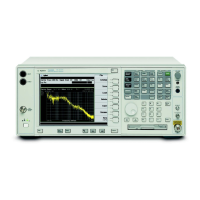Chapter 2 57
Installation and Setup
Calibrating System Components
Measurement Procedure Using a N5532A/B Sensor Module
Step 1. Connect, configure, and verify the measurement system. See “System Hardware
Connections” on page 44 and “System Configuration” on page 47.
Step 2. Calibrate the power meter. See “Zero and Calibrate the Power Meter” on page 53.
Step 3. Connect the sensor module to the signal source and assure proper connector care
and connector torque settings are followed. SMA/ 3.5mm connectors should
receive 8 inch-pounds of torque and Type N connectors 12 in-pounds.
Step 4. On the PSA, perform the Auto Align routine by pressing
System, Alignments, Align
All Now
.
Step 5. Set the signal source amplitude and frequency. For this example use 0 dBm and 50
MHz. Do not change any settings during this procedure.
Step 6. Configure the PSA settings as follows:
NOTE Range 3 Switch Delay (Early instruments only)
Applies only to instruments with Option Driver part number E444060253 and
firmware release less than A.11.00. Press
System, More, Show Hardware to view
the option driver part number.
When range 3 is entered, several internal PSA settings are changed including
enabling the optional preamp and decreasing input attenuation. For optimum
accuracy, a delay of five minutes is initiated when this function is ON. The delay
allows the preamplifier to stabilize. Assure the Range 3 Switch Delay is On for
both the Range Calibration and the TRFL measurement process since you may
perform the Range Calibration as a separate routine.
Table 2-6 PSA Settings
Parameter Setting
Mode Measuring Receiver
Measure Tuned RF Level
Frequency
Note: Do not use the Frequency Counter
function. You must press the Frequency key
and set the frequency manually.
Same as signal source frequency
Range 3 Switch Delay
(Under Meas Setup, More)
See note below
May choose On or Off.
Default is Off
Range Switching Default is Auto
10 MHz Out
(Under System, Reference)
ON
Freq Ref
(Under System, Reference)
Int

